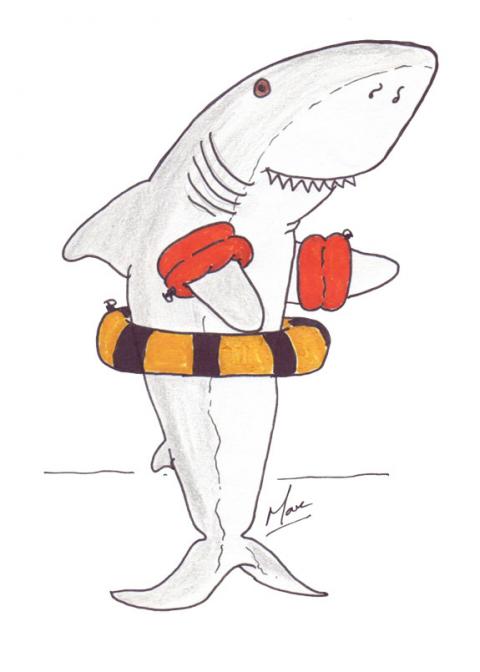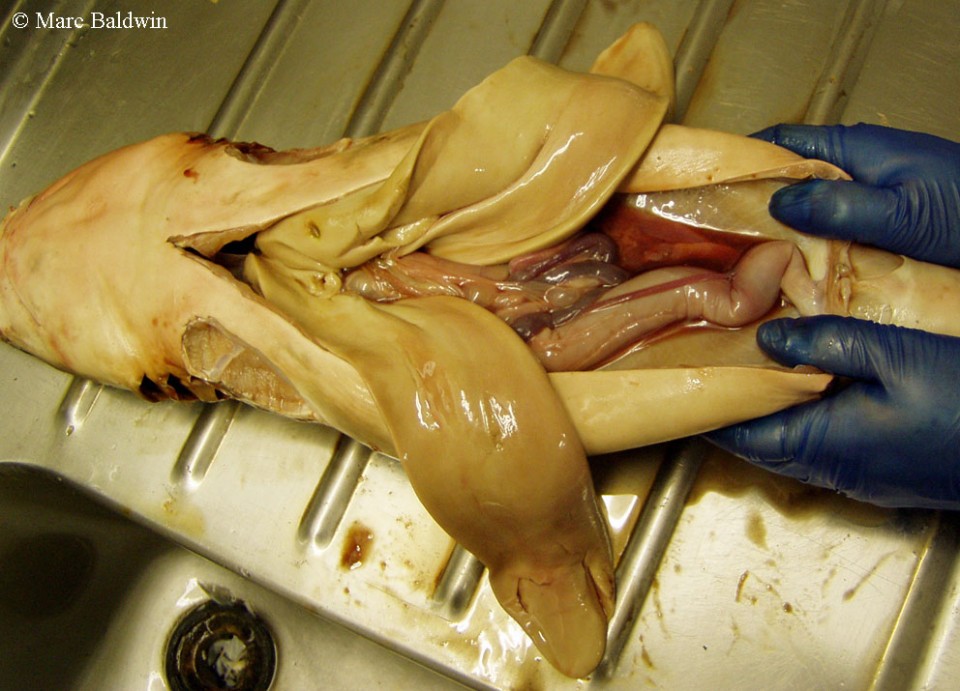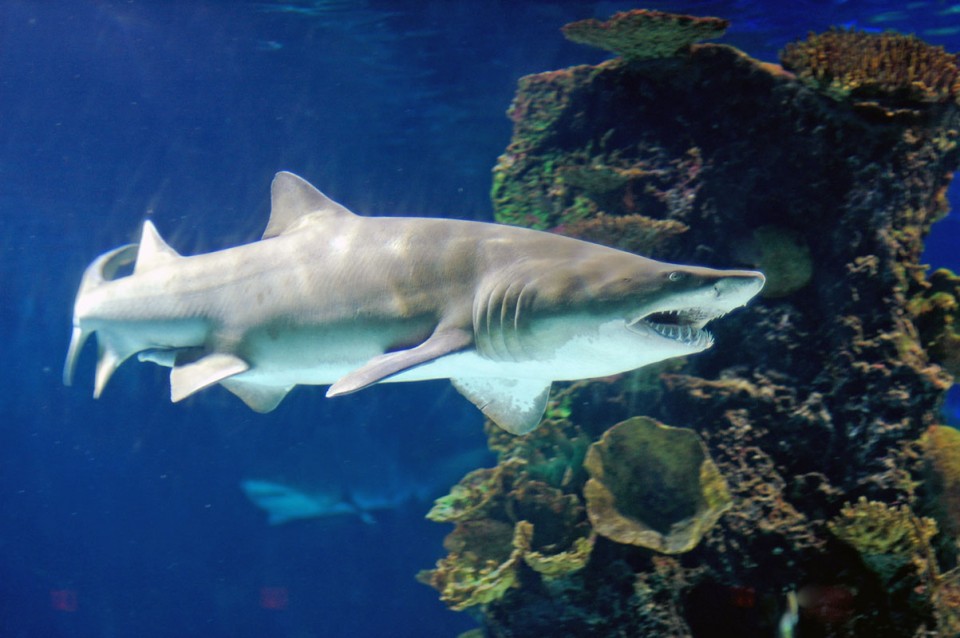Many bony fishes have a swim-bladder, the presence or absence of which is related to the animal's life habits. With few exceptions, the swim-bladder is an oval sac lying in the abdomen just below the vertebral column and is filled either by gulping air, in fishes that have a connection between bladder and oesophagus (a physostome bladder), or from diffusion of gas from the blood into the bladder (a physoclist bladder). Air is less dense than water and so provides a source of buoyancy to the fish. Elasmobranchs don’t have a swim-bladder, and they must find other ways to regulate their buoyancy; this is achieved via several methods.

The primary aspect that gives sharks and rays buoyancy is a large liver filled with low-density oil (870 to 880 grams per litre at room temperature). The main component of elasmobranch liver oil is squalene, a chemical formed partway along the chain to cholesterol whose low density makes it well suited to providing a source of static lift. According to a 1972 paper by H. David Baldrige Jr., liver oil is accumulated at an almost constant weight to tissue ratio in the liver of larger sharks – although the amount present in any given shark at a set time is related not only to species but also body condition. Indeed, in his 1960 paper on the natural history of the sandbar shark (Carcharhinus plumbeus), the eminent late shark biologist Stewart Springer wrote that fatty livers are an indication of metabolic well-being in sharks, with small livers containing little oil frequently associated with sharks having severe injuries, individuals in obviously poor condition, or males at the end of the mating season.
Squalene and other lipids accumulate in large fluid-filled cavities in the cytoplasm of the liver cells called fat vacuoles and may constitute 80% or more of the liver volume – in some of the pelagic (open ocean) sharks, squalene may represent as much as 90% of the liver oil, giving almost neutral buoyancy. It is believed that many sharks can go long periods without feeding by metabolising their liver oil stores. Indeed, in a 1964 paper H.A.F. Gohar and M.F Mazhar report on a pregnant whitetip reef shark (Triaenodon obesus), which survived for six weeks without food in their vivarium. The shark’s liver weight decreased by just under 50%, suggesting that she was metabolising her liver oils.
Precisely how sharks regulate their buoyancy is still something of an enigma. A series of ingenious experiments by Quentin Bone at the Marine Biological Laboratory in Plymouth suggested that squaloid (dogfish) sharks may regulate their buoyancy not by altering the amount of squalene in the liver oil, but by varying less abundant components. By hanging weights on the dogfish, Bone found that the sharks responded by increasing the amount of specialised low-density fats called alkoxydiglycerides at the expense of more dense triglyceride fats. This has, however, yet to be demonstrated in any other species.
It is not only liver oil that gives elasmobranchs buoyancy and several factors contribute to over-all lift. On his ReefQuest site Aidan Martin noted that as much as 30% of a shark’s hydrodynamic lift (i.e. that caused by moving through the water) is a result of their flattened snouts and ventrum (belly). Indeed, several studies have recently altered our classical perceptions of how sharks employ hydrodynamics to achieve lift. In a 1986 paper published in the Journal of Fish Biology, it was proposed that negatively buoyant fishes (i.e. those that would sink without some buoyancy aid) may adopt a positive body tilt (i.e. nose up, tail down) during steady swimming to increase total lift. Indeed, subsequent studies on a small north leopard shark (Triakis semifasciata) have shown that they appear to actively alter their body tilt as required in order to moderate the amount of lift generated by their body profile.

Classically, we thought the pectoral fins served to generate list to counteract the lift created by the tail. In other words, as the shark swims their tail is pushed up by the water, forcing the head down; pectoral fins were thought to help balance this out. Experiments by Cheryl Wilga, at the University of California at Irvine, and George Lauder, at Harvard University, have cast doubt on this idea, however. In Triakis, at least, the pectoral fins produce negligible lift during normal horizontal swimming; Wilga and Lauder proposed five different components that interact to off-set the lift generated by the tail during swimming.
Some authors suggest that the cartilaginous skeleton may also serve to aid buoyancy; cartilage is about half the density of bone and a frame composed of cartilage would be considerably lighter than the same one composed of bone. Perhaps the most intriguing suggestion for a buoyancy-aid, however, comes from a 1994 paper in the Journal of Experimental Biology. In this paper, a team of Australian researchers suggested that urea and trimethylamine oxide have a substantial effect on the buoyancy of marine elasmobranchs, contributing as much as five to six grams per litre. Trimethylamine oxide, or TMAO, is a special chemical retained in shark blood to counteract the destabilizing effects of urea, which itself is retained to help maintain the shark’s osmotic balance, on proteins and it seems to contribute more to this positive buoyancy than urea.
Finally, some sharks employ air gulping as a way of controlling their buoyancy. There are several species in which air gulping is well known; most are the aptly-named swellsharks (members of the catshark family). There are 16 species of swellshark and, in most instances, they use this method to wedge themselves in rock crevices so that predators cannot dig them out. One shark that uses air gulping to an entirely different end is the sandtiger shark (Carcharias taurus). Sandtigers gulp air at the surface, holding it in their stomachs and “farting” it out gradually until the desired depth is achieved. This retention of air allows the shark to hover almost motionless at a depth of its choosing.

Consequently, without a swim bladder, elasmobranchs rely on several factors to keep from sinking. Their large oily liver is particularly important; but it’s only one adaptation that helps keep them afloat.